Synthetic fusion gene and its use thereof
Vinodh Kumar , et al. De
U.S. patent number 10,494,655 [Application Number 15/301,520] was granted by the patent office on 2019-12-03 for synthetic fusion gene and its use thereof. This patent grant is currently assigned to UNIVERSITI BRUNEI DARUSSALAM. The grantee listed for this patent is UNIVERSITI BRUNEI DARUSSALAM. Invention is credited to Zohrah Sulaiman, Prabitha Vinodh Kumar.


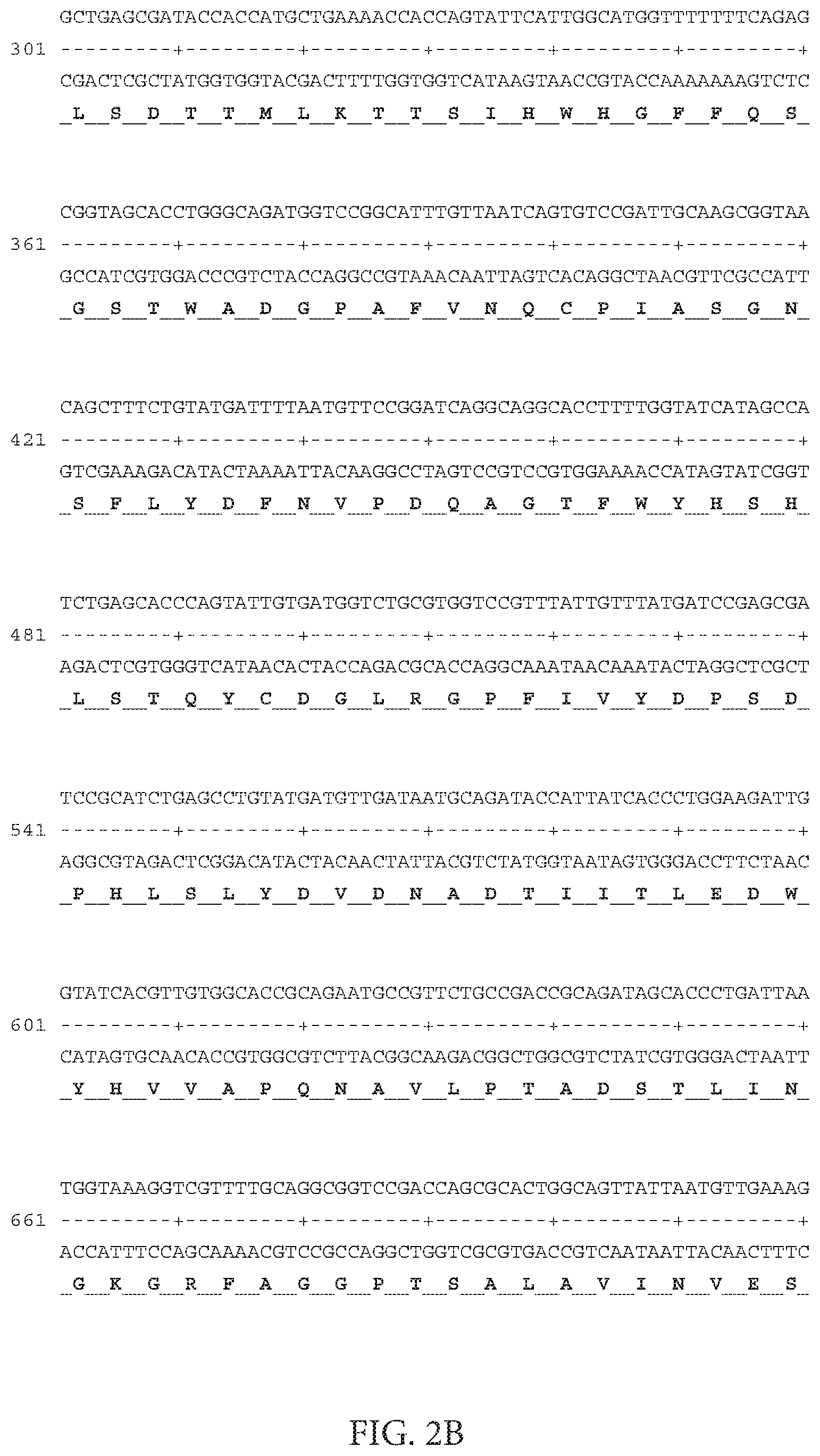
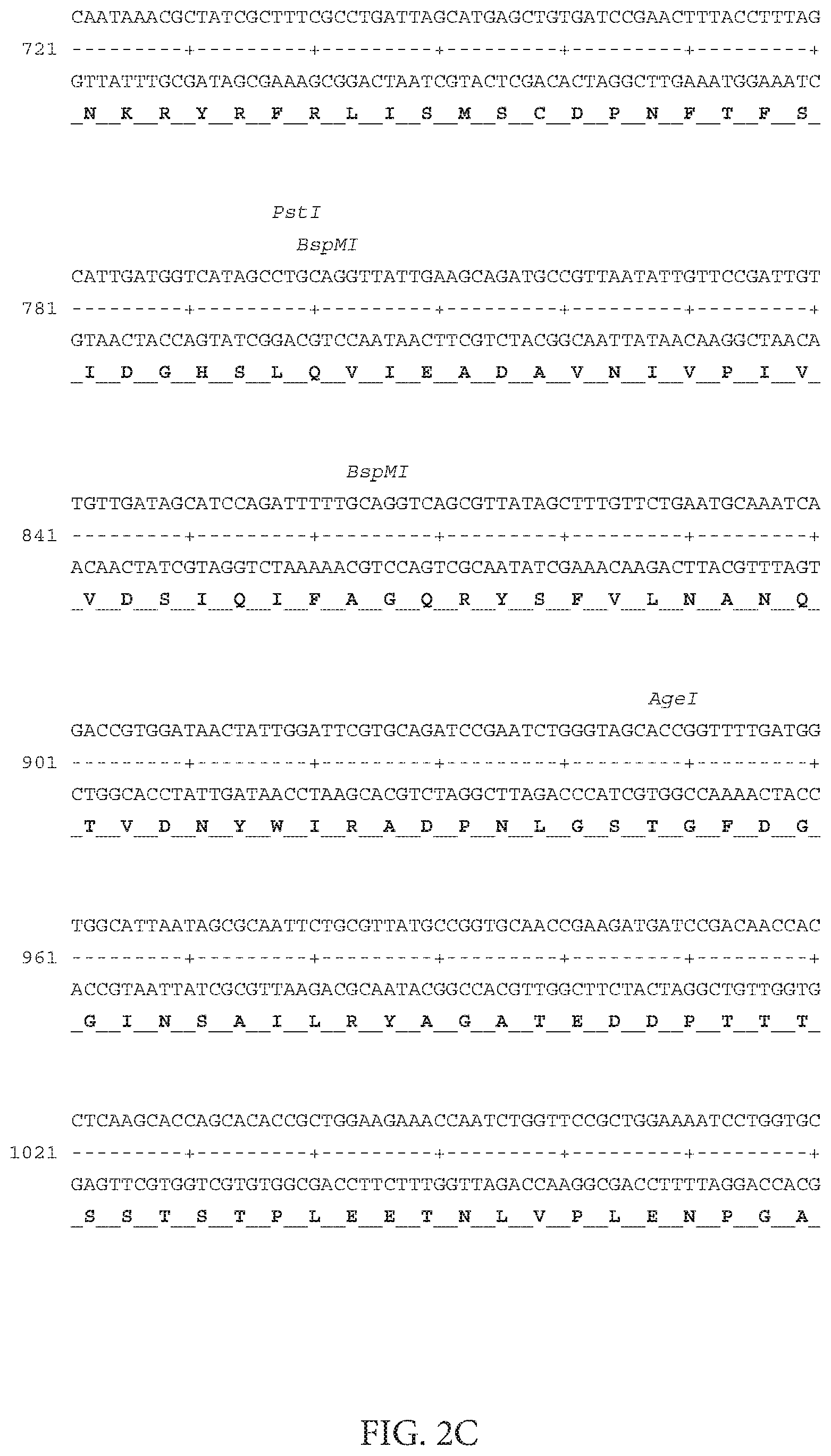
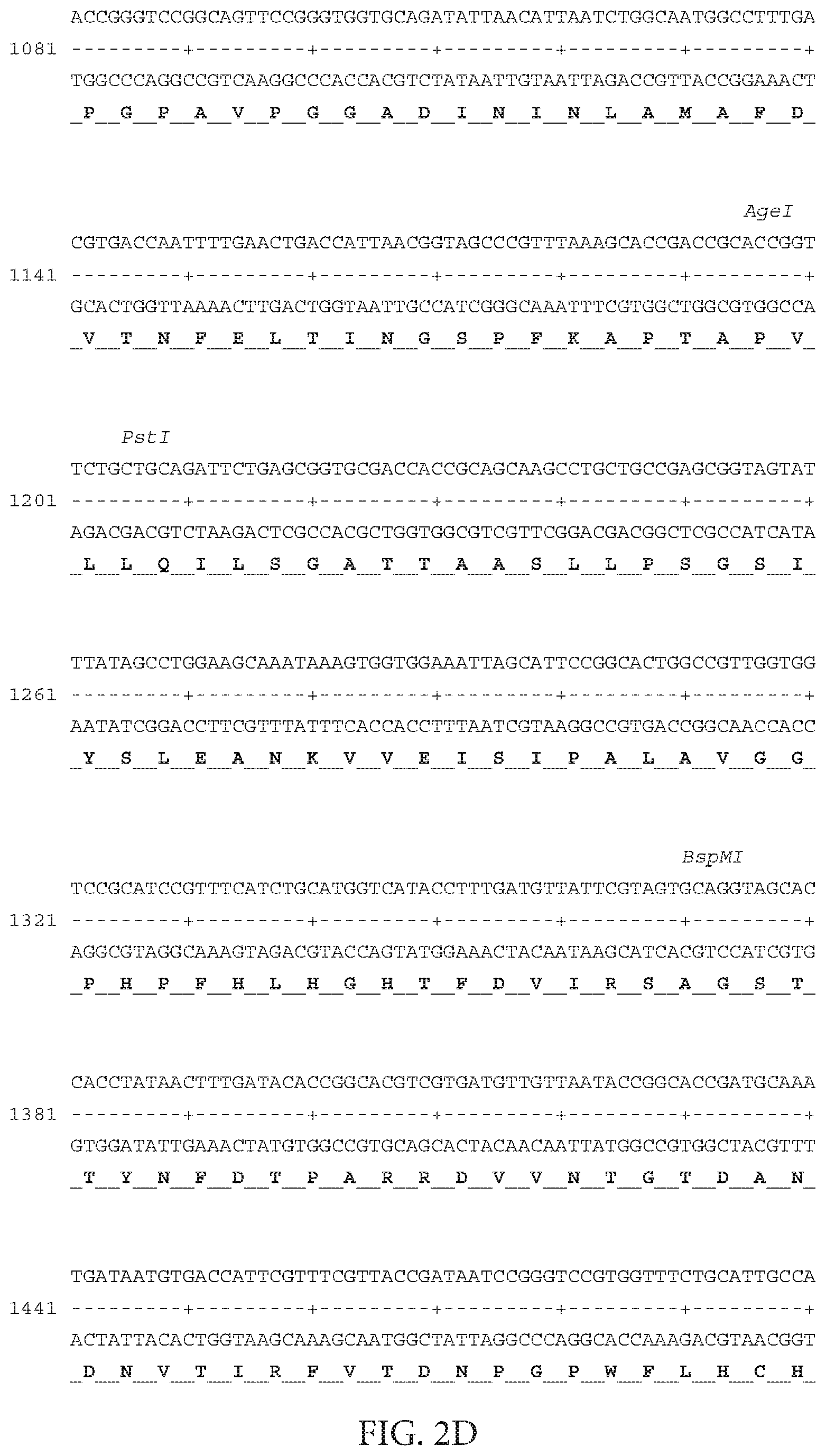
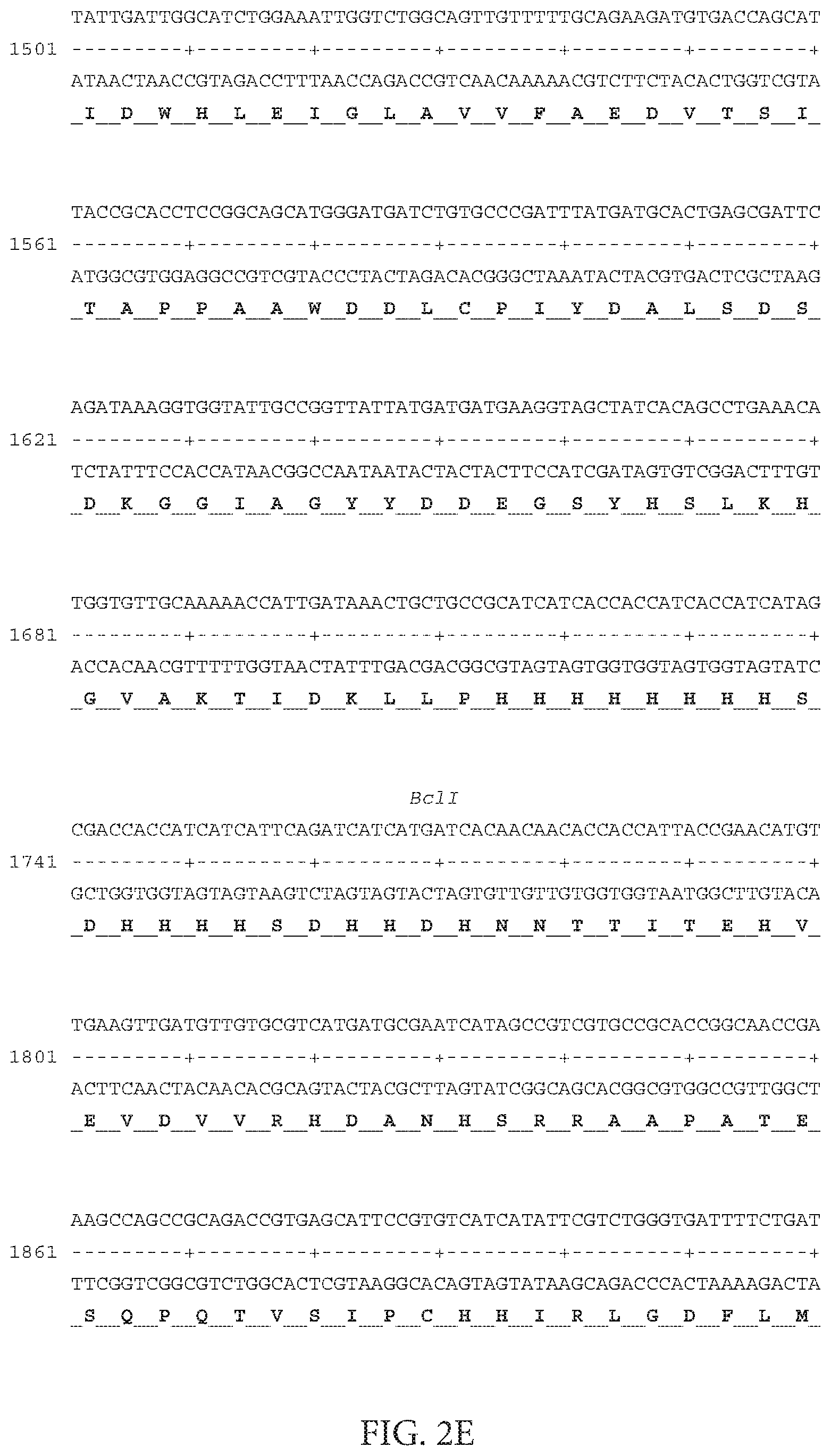
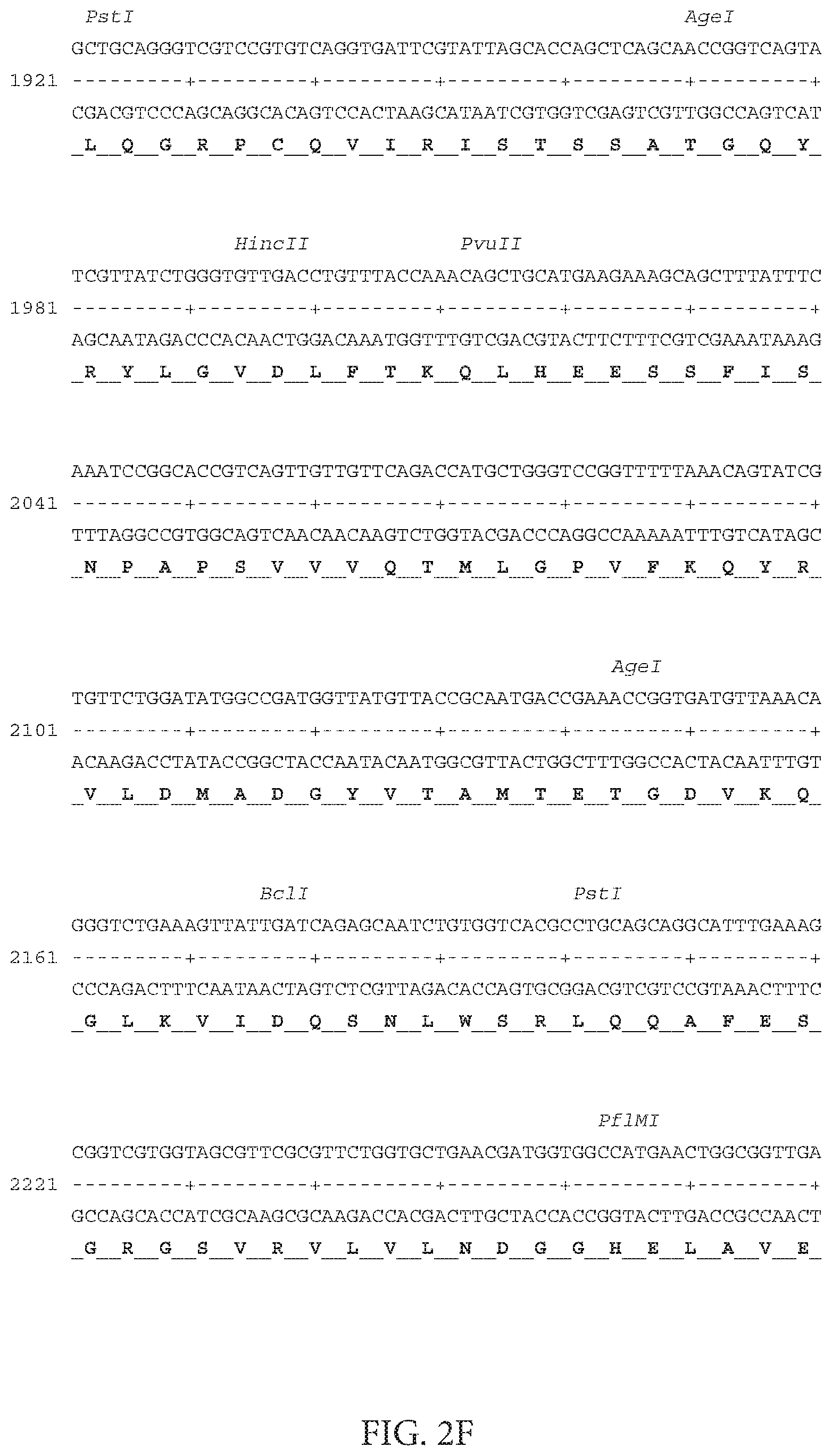

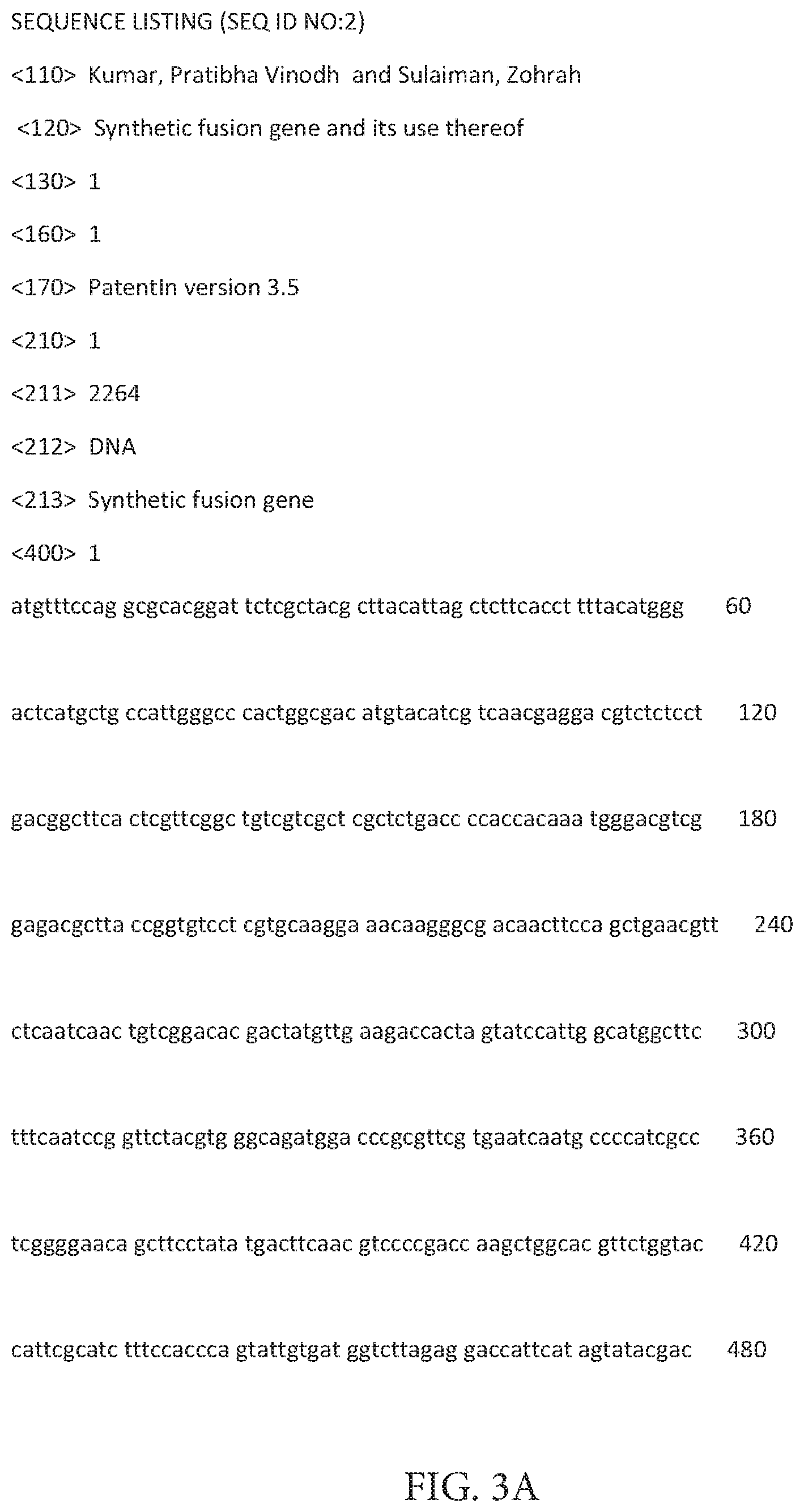
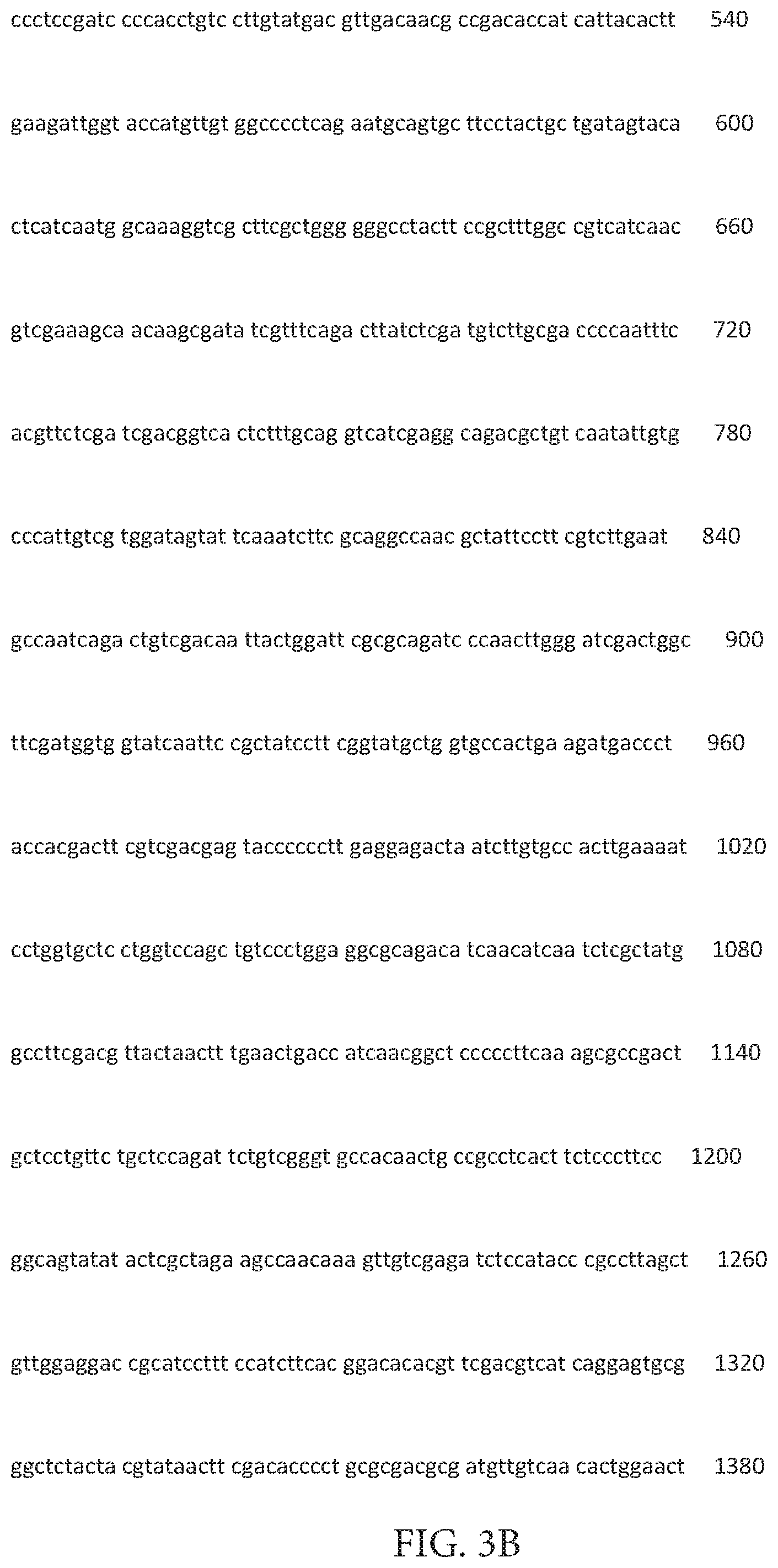
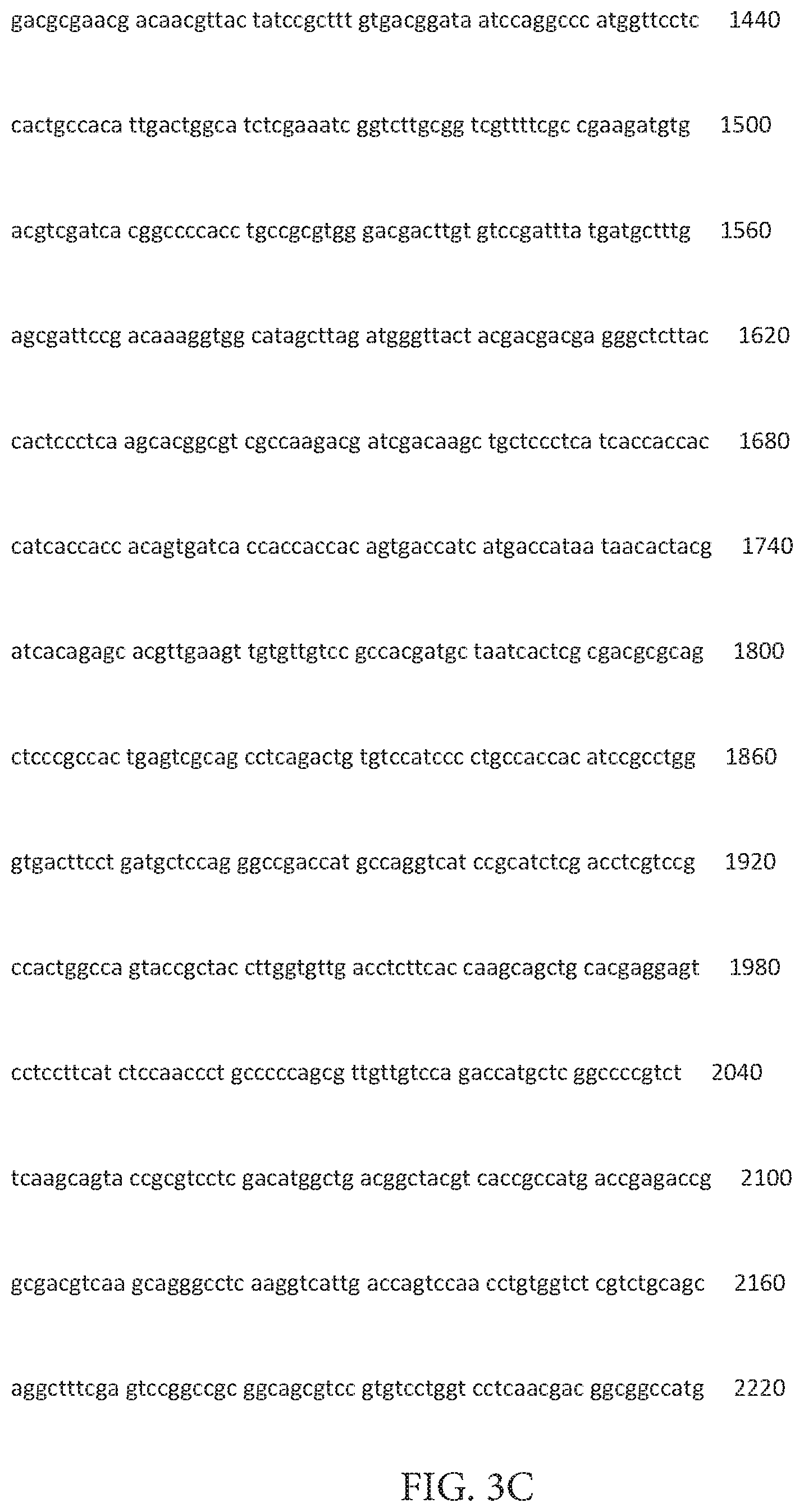
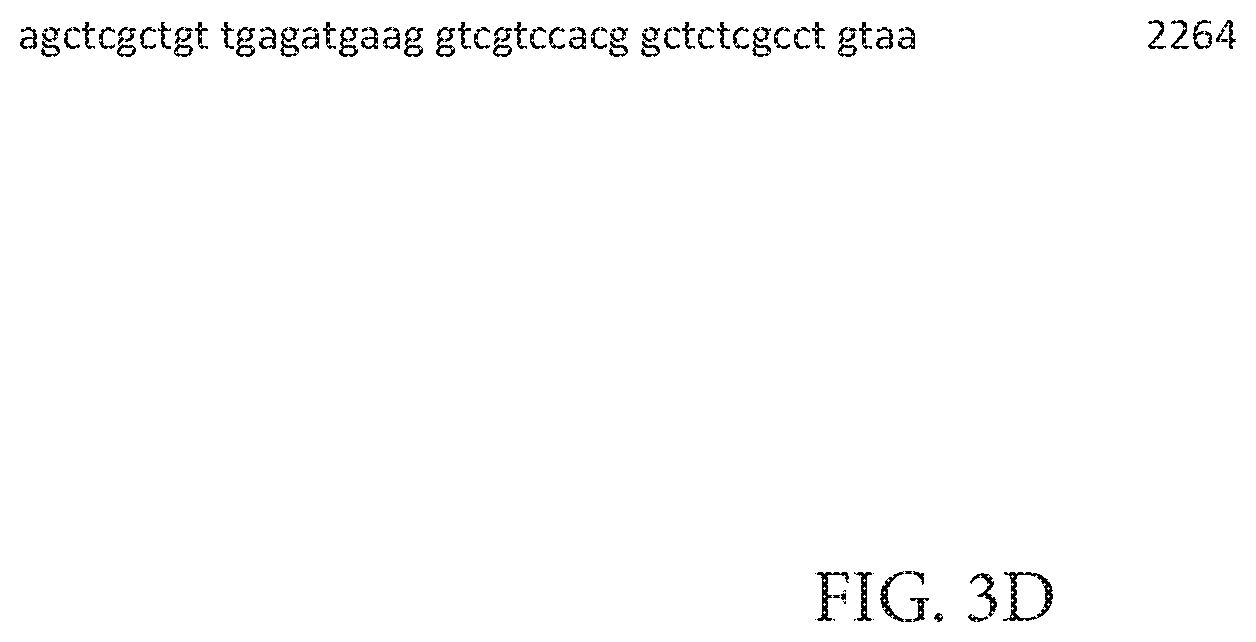
View All Diagrams
| United States Patent | 10,494,655 |
| Vinodh Kumar , et al. | December 3, 2019 |
Synthetic fusion gene and its use thereof
Abstract
The present invention discloses synthetic fusion gene comprising hex1 and pox1 genes, their process of preparation, polypeptide(s) encoded by the same and its use thereof for biological pre-treatment of biomass for the production of biodiesel.
| Inventors: | Vinodh Kumar; Prabitha (Gadong, BN), Sulaiman; Zohrah (Gadong, BN) | ||||||||||
|---|---|---|---|---|---|---|---|---|---|---|---|
| Applicant: |
|
||||||||||
| Assignee: | UNIVERSITI BRUNEI DARUSSALAM
(Gadong, BN) |
||||||||||
| Family ID: | 54239480 | ||||||||||
| Appl. No.: | 15/301,520 | ||||||||||
| Filed: | April 1, 2015 | ||||||||||
| PCT Filed: | April 01, 2015 | ||||||||||
| PCT No.: | PCT/IB2015/052385 | ||||||||||
| 371(c)(1),(2),(4) Date: | October 03, 2016 | ||||||||||
| PCT Pub. No.: | WO2015/151038 | ||||||||||
| PCT Pub. Date: | October 08, 2015 |
Prior Publication Data
| Document Identifier | Publication Date | |
|---|---|---|
| US 20190153487 A1 | May 23, 2019 | |
Foreign Application Priority Data
| Apr 3, 2014 [BN] | BN/N/2014/0037 | |||
| Current U.S. Class: | 1/1 |
| Current CPC Class: | C12N 9/0071 (20130101); C12N 9/2437 (20130101); C12P 7/649 (20130101); C12P 19/02 (20130101); C12N 15/62 (20130101); C12Y 302/01004 (20130101); C12P 19/14 (20130101); C12Y 114/18001 (20130101); C12P 2201/00 (20130101); C07K 2319/00 (20130101) |
| Current International Class: | C12P 7/64 (20060101); C12P 19/14 (20060101); C12N 9/42 (20060101); C12N 9/02 (20060101); C12N 15/62 (20060101); C12P 19/02 (20060101) |
References Cited [Referenced By]
U.S. Patent Documents
| 7981650 | July 2011 | Levasseur et al. |
| 2012/0083012 | April 2012 | Chang et al. |
| WO 2005/093050 | Oct 2005 | WO | |||
| WO 2007/094852 | Aug 2007 | WO | |||
| WO 2011/153276 | Dec 2011 | WO | |||
Other References
|
Curach et al., Isolation, characterization and expression of the hex1 gene from Trichoderma reesei. Gene, 2004, vol. 331: 133-140. (Year: 2004). cited by examiner . Kisselev L., Polypeptide release factors in prokaryotes and eukaryotes: same function, different structure. Structure, 2002, vol. 10: 8-9. (Year: 2001). cited by examiner . Moussa TAA., Cloning and sequncing of phenol oxidase 1 (pox1) gene from Pleurotus ostreatus. African J. Biotechnol., 2011, vol. 10(8): 1299-1308. (Year: 2011). cited by examiner . Prabitha Vinodh Kumar & Zohrah Sulaiman., Use of synthetic fusion gene to produce biodiesel from lignocellulosic biomass. Biofuels, 2016, vol. 7(2): 191-200. (Year: 2016). cited by examiner . Seffernick et al., Melamine deaminase and Atrazine chlorohydrolase: 98 percent identical but functionally different. J. Bacteriol., 2001, vol. 183 (8): 2405-2410. (Year: 2001). cited by examiner . Whisstock et al., Prediction of protein function from protein sequence. Q. Rev. Biophysics., 2003, vol. 36 (3): 307-340. (Year: 2003). cited by examiner . Wishart et al., A single mutation converts a novel phosphotyrosine binding domain into a dual-specificity phosphatase. J. Biol. Chem., 1995, vol. 270(45): (Year: 1995). cited by examiner . Witkowski et al., Conversion of b-ketoacyl synthase to a Malonyl Decarboxylase by replacement of the active cysteine with glutamine. Biochemistry, 1999, vol. 38: 11643-11650. (Year: 1999). cited by examiner . Kim, H.M et al., Improving lignocellulose degradation using xylanase-cellulase fusionprotein with a glycine-serine linker, International Journal . . . Dec. 3, 2014, vol. 73. cited by applicant. |
Primary Examiner: Raghu; Ganapathirama
Attorney, Agent or Firm: Sinorica, LLC
Claims
What is claimed is:
1. A polypeptide comprising the amino acid sequence of SEQ ID NO:1, wherein the polypeptide is capable of hydrolysing lignocellulosic biomass.
2. A polynucleotide comprising the nucleotide sequence of SEQ ID NO:2.
3. The polynucleotide as claimed in claim 2, capable of encoding the polypeptide, the polypeptide comprising amino acid sequence of SEQ ID NO: 1.
4. The polynucleotide as claimed in claim 2, wherein the SEQ ID NO: 2 is obtained from Tricoderma reesei (hex 1) and Pleurotous sojar caju (pox 1) gene.
5. A synthetic fusion gene comprising Tricoderma reesei (hex1) and Pleurotous sojar caju (pox1) wherein the hex1 and the pox1 are joined together by arranging their cDNA nucleotides.
6. The synthetic fusion gene of claim 5 wherein: end codon of the hex1 is spliced and start codon of the pox1 is attached to the spliced end condon of the hex 1 by synthetic arrangement of nucleotides.
Description
CROSS-REFERENCE TO RELATED APPLICATIONS
The present application claims priority to Brunei Patent Application No. BN/N/2014/0037, entitled "Synthetic Fusion Gene and its use thereof" and filed on Apr. 3, 2014, the contents of which are hereby incorporated by reference.
FIELD OF THE INVENTION
The present invention relates to synthetic fusion gene comprising hex1 and pox1 genes, their process of preparation, polypeptide(s) encoded by the same and their use thereof.
BACKGROUND OF THE INVENTION
There is a growing interest in using renewable feedstock for manufacturing biofuels, such as bioethanol, biochemical and biodiesel. As such, pre-treatment of the biomass is needed to increase the rate and/or yield of biofuel production.
Currently, the main methods used for pre-treatment are physical, such as milling, or chemical, such as acid pre-treatment. However, biological methods are a promising alternative since no harmful chemicals are used and less energy input is required.
However, pre-treatment attempts to date have fallen short of the desired economic and technical performance. Thereby, there exists a need for effective, economical pre-treatments to make these polysaccharides available at a sufficiently high yield and acceptable cost.
BRIEF SUMMARY OF THE INVENTION
The present invention discloses synthetic fusion gene comprising hex1 and pox 1 genes, their process of preparation, polypeptide(s) encoded by the same and its use thereof for biological pre-treatment of biomass for the production of biodiesel.
In an embodiment, the present invention provides a polypeptide comprising an amino acid sequence of SEQ ID NO:1.
In another embodiment, it provides a polynucleotide comprising a nucleotide sequence of SEQ ID NO:2. It further describes the polynucleotide, capable of encoding a polypeptide, wherein the polypeptide comprising an amino acid sequence of SEQ ID NO. 1.
In another embodiment, the polynucleotide comprising SEQ ID NO 2 is obtained from hex 1 and pox1 gene.
In yet another embodiment, it discloses a vector comprising a polynucleotide, wherein the polynucleotide comprising a nucleotide sequence of SEQ ID NO:2.
The invention further provides a method of biological pretreatment for biofuel production comprising, introducing a vector in a host cell under conditions suitable for the expression of the vector, wherein the vector comprising a nucleotide sequence of SEQ ID NO:2 which is capable of encoding a polypeptide, the polypeptide comprising an amino acid sequence of SEQ ID NO:1.
It further discloses the method of biological pre-treatment for biofuel production, wherein the polypeptide is capable of hydrolysing lignocellulo sic biomass.
The present invention solves the long standing need of pure biological treatment, removing the need of any additional physical or chemical pre-treatment step. Further, since polynucleotide comprising a nucleotide sequence of SEQ ID NO:2 is a pure biological agent there is no hazard to the environment.
The present invention, also provides quick and cheaper method of pre-treatment of biomass as nucleotide sequence of SEQ ID NO:2 can be replicated and can be used two or more times.
BRIEF DESCRIPTION OF THE DRAWINGS
FIG. 1 shows the plasmid containing synthetic fusion gene along with biodiesel producing gene.
FIG. 2A shows the first part of polypeptide comprising an amino acid sequence according to the present invention encoded by the synthetic fusion gene comprising hex1 and pox1 genes. FIG. 2B shows the second part of polypeptide comprising an amino acid sequence. FIG. 2C shows the third part of polypeptide comprising an amino acid sequence. FIG. 2D shows the fourth part of polypeptide comprising an amino acid sequence. FIG. 2E shows the fifth part of polypeptide comprising an amino acid sequence. FIG. 2F shows the sixth part of polypeptide comprising an amino acid sequence. FIG. 2G shows the seventh part of polypeptide comprising an amino acid sequence. SEQ ID NO: 1 is referred by bold letter in sequence listing and SEQ ID NO: 2 is referred by light letters in sequence listing.
FIG. 3A shows the first part of polynucleotide sequence of synthetic fusion gene comprising hex1 and pox1 genes. FIG. 3B shows the second part of polynucleotide sequence of synthetic fusion gene comprising hex1 and pox1 genes. FIG. 3C shows the third part of polynucleotide sequence of synthetic fusion gene comprising hex1 and pox1 genes. FIG. 3D shows the fourth part of polynucleotide sequence of synthetic fusion gene comprising hex1 and pox1 genes. (SEQ ID NO: 2)
DEFINITIONS
The term "polypeptide" corresponds to any chain of amino acids, regardless of length or post-translational modification (glycosylation or phosphorylation).
The term "polynucleotide" corresponds to any genetic material of any length and any sequence, comprising single-stranded and double-stranded DNA and RNA molecules, including regulatory elements, structural genes, groups of genes, plasmids, whole genomes and fragments thereof.
The term "nucleic acid molecule" is intended to indicate any single- or double stranded nucleic acid molecule of cDNA, genomic DNA, synthetic DNA or RNA, PNAS or LNA origin.
The term "plasmid", "vector system" or "expression vector" means a construct capable of in-vivo or in-vitro expression.
The term "host cell" in relation to the present invention includes any cell that comprises either the nucleic acid molecule or an expression vector as described above and which is used in the production of polypeptide having the specific properties as defined herein or in the methods of the present invention.
DETAILED DESCRIPTION OF THE INVENTION
For the purpose of promoting and understanding of the principles of the invention, reference will now be made to embodiments and specific language will be used to describe the same. It will nevertheless be understood that no limitation of the scope of the invention is thereby intended, such alterations and further modifications in the disclosed process, and such further applications of the principles of the invention therein being contemplated as would normally occur to one skilled in the art to which the invention relates.
Reference throughout this specification to "one embodiment" "an embodiment" or similar language means that a particular feature, structure, or characteristic described in connection with the embodiment is included in at least one embodiment of the present invention. Thus, appearances of the phrase "in one embodiment", "in an embodiment" and similar language throughout this specification may, but do not necessarily, all refer to the same embodiment.
The present invention discloses synthetic fusion gene comprising hex1 and pox1 genes, their process of preparation, polypeptide(s) encoded by the same and its use thereof for biological pre-treatment of biomass for the production of biodiesel.
The invention further discloses that the synthetic fusion gene was constructed using bioinformatics tools to help complete hydrolysis of lignocelluloses of Laila paddy into glucose for the production of biodiesel from (husk/straw) of Laila paddy.
The present disclosure relates to a polypeptides comprising an amino acid sequence of SEQ ID NO: 1 as referred by bold letter in sequence listing of FIG. 2A, FIG. 2B, FIG. 2C, FIG. 2D, FIG. 2E, FIG. 2F, and FIG. 2G.
In another aspect, the disclosure provides a polynucleotide comprising a nucleotide sequence of SEQ ID NO:2. It further describes the polynucleotide, capable of encoding a polypeptide, wherein the polypeptide comprising an amino acid sequence of SEQ ID NO: 1.
In further discloses that, the polynucleotide comprising SEQ ID NO: 2 is obtained from hex1 and pox1 gene.
In order to produce a polypeptide, it discloses a vector comprising a polynucleotide, wherein the polynucleotide comprising a nucleotide sequence of SEQ ID NO: 2.
The invention further provides a method of biological pre-treatment for biofuel production, wherein the polynucleotide comprising SEQ ID NO: 2 is included in an expression cassette and/or cloned into a suitable expression vector by standard molecular cloning techniques. The expression cassette or vector is introduced into a suitable expression host cell, which then expresses the corresponding polypeptide comprising SEQ ID NO: 1.
It further discloses the method of biological pre-treatment for biofuel production, wherein the polypeptide is capable of hydrolysing lignocellulosic biomass.
The present invention solves the long standing need of pure biological treatment, removing the need of any additional physical or chemical pre-treatment step. Further, since polynucleotide comprising a nucleotide sequence of SEQ ID NO:2 is a pure biological agent there is no hazard to the environment.
The present invention, also provides quick and cheaper method of pre-treatment of biomass as nucleotide sequence of SEQ ID NO: 2 can be replicated and can be used two or more times.
In an embodiment, the present invention arranges synthetic fusion gene to help complete hydrolysis of lignocelluloses of Laila paddy into glucose for production of biodiesel from hust/straw of laila paddy. The invention arranges Hex 1 and Pox1. Hex1 is a fungi which is mainly used for hydrolysis of cellulose and hemicelluloses in pretreatment. Pox1 is a mushroom which is used to break down lignin in lignocelluloses. The invention joins Hex1 and Pox1 together by arranging their cDNA nucleotides to construct new synthetic fusion gene.
In another embodiment, end codon of Tricoderma reesei (hex 1) is spliced and start codon of Pleurotus sojar caju (pox1) is attached to it by synthetic arrangement of nucleotides. Pleurotus sojar cajus (pox1) stop codon act as end codons for both genes. Therefore, fusion gene work as a single gene having both properties of hex 1 and pox 1.
For any Production of Biodiesel/micro diesel from ligno cellulose (Cellulose, hemicellulose & lignin) it is necessary to do a pre-treatment. However, no additional pretreatment process is required when novel fusion gene is used and fermentation step can be carried out without pretreatment. Synthetic fusion gene can be placed in same plasmid along with other gene used for production of biodiesel.
A Pre-treatment is a phase in which the lignocelluloses materials such as wood or straw is amenable to hydrolysis. Pre-treatment technique has been generally divided into physical, chemical and biological. Physical Treatment includes Milling and Grinding, Chemical Treatment includes Using Acids or alkali, and Biological Treatment includes mostly using Rot Fungi in combination with Physical treatment. However using the synthetic gene there is no need for a pre-treatment as the fusion gene is placed in the same plasmid along with biodiesel producing gene. Hence, hydrolysis of ligno cellulose takes place along with biodiesel production during fermentation.
Generally lignocelluloses has to undergo first a Combined pretreatment (Physical, Chemical, and an expensive Enzymatic treatment) prior to fermentation process. However the pre-treatment does not break the lignin or through some enzymes only partial breakdown of lignin is achieved. Thus a major part of lignin remain intact which is also a carbon source that is wasted. The present invention is a one step process in which invitro enzymatic pretreatment resulting from fusion gene hex1pox1 & fermentation takes place in the same medium. Also complete breakdown of lignin is achieved thereby increasing the production of biodiesel as all sources of carbon from lignocelluloses are utilized.
In another embodiment, Aerobic Fermentation was used. Fermentation flask was immersed in a temperature controlled water bath maintained at 37.degree. C. and stirred at 250-280 rpm for 24 hours. pH was maintained within the range of 6.8 to 7. Lower temperatures upto 30 deg C. was tried, the growth of bacteria was not seen in the medium. Higher temperature yielded a turbid medium within 6 hours indicating full growth however resulted a very low yield. Thus 37 deg C. was the optimal temperature which resulted in the best yield.
The synthetic fusion gene comprises of hex1 and pox1 gene by synthetic arrangement of nucleotides, wherein hex1 and pox1 helps in hydrolysis of cellulose, hemicelluloses and lignin. The synthetic fusion gene helps in complete hydrolysis of lignocellulose into glucose without the use of any pre-treatment method for biodiesel production from paddy.
In another embodiment, the synthetic fusion gene can also be used as a pure biological pre-treatment tool for any production of micro diesel. The Synthetic gene is also used in p Cola duet 1 Z.
In another embodiment Genes hex1 and pox1 play the role of degradation of lignocellulose.
In an embodiment, the invention may be used on Biomass to produce biofuel. The biomass includes Laila paddy, husk and straw. Oriza sativa having same chemical component or any lignocellulose biomass having same component with different ratio can also be used as biomass.
In an embodiment, Fad E. del E. coli is used as host organism. Gene is optimized for E. coli. For other host organism like mammalian, insect and yeast expression a KOZAK sequence is recommended to the upstream of the construct.
In another embodiment, other gene that are combined with pox1 hex1 are pdc, adh, and aft A. pdc & adh help in production of ethanol and aft A helps in the conversion of ethanol into biodiesel). Thus these gene (pdc, adh, aft A) complement fusion gene in producing biodiesel not in any hydrolytic process of lignocellulose.
Construction of Synthetic Fusion Gene:
Tricoderma reesei (hex1) is a fungi which is mainly used for hydrolysis of cellulose and hemicelluloses in pre-treatment and Pleurotous sojar caju (pox1) is a mushroom which is used to breakdown lignin in lignocelluloses. These two particular genes hex1 and pox1 play the role of degradation in these fungi. In the present invention, hex 1 and pox1 were joined together by arranging their cDNA nucleotides, to construct new synthetic fusion gene. Here end codon of Tricoderma reesei (hex 1) was spiked and Pleurotous sojar caju (pox1) start codon was attached to it by synthetic arrangement of nucleotides. The stop codon of Pleurotous sojar caju (pox 1) acts as end codons for both the genes. Thus, the fusion gene works as single gene having both properties.
SPECIFIC EMBODIMENTS ARE DESCRIBED BELOW
A polypeptide comprising an amino acid sequence of SEQ ID NO: 1 as referred by bold letter in sequence listing of FIG. 2A, FIG. 2B, FIG. 2C, FIG. 2D, FIG. 2E, FIG. 2F, and FIG. 2G.
FURTHER SPECIFIC EMBODIMENTS ARE DESCRIBED BELOW
A polynucleotide comprising a nucleotide sequence of SEQ ID NO: 2 as referred by light letter in sequence listing of FIG. 2A, FIG. 2B, FIG. 2C, FIG. 2D, FIG. 2E, FIG. 2F, and FIG. 2G.
Such polynucleotide(s), capable of encoding a polypeptide, the polypeptide comprising an amino acid sequence of SEQ ID NO. 1.
Such polynucleotide(s), wherein the SEQ ID NO 2 is obtained from hex1 and pox1 gene.
FURTHER SPECIFIC EMBODIMENTS ARE DESCRIBED BELOW
A vector comprising a polynucleotide, the polynucleotide comprising a nucleotide sequence of SEQ ID NO: 2.
FURTHER SPECIFIC EMBODIMENTS ARE DESCRIBED BELOW
A method of biological pre-treatment for biofuel production comprising: introducing a vector in a host cell under conditions suitable for the expression of the vector, wherein the vector comprising a nucleotide sequence of SEQ ID NO:2 which is capable of encoding a polypeptide, the polypeptide comprising an amino acid sequence of SEQ ID NO:1.
Such method(s), wherein the polypeptide is capable of hydrolysing lignocellulosic biomass.
INDUSTRIAL APPLICABILITY
The present invention discloses the method of biological pre-treatment for biofuel production, wherein the polypeptide is capable of hydrolysing lignocellulosic biomass.
Further, the present invention solves the long standing need of pure biological treatment, removing the need of any additional physical or chemical pre-treatment step. Further, since polynucleotide comprising a nucleotide sequence of SEQ ID NO: 2 is a pure biological agent there is no hazard to the environment.
Furthermore, the present invention, also provides quick and cheaper method of pre-treatment of biomass as nucleotide sequence of SEQ ID NO: 2 can be replicated and can be used two or more times
SEQUENCE LISTINGS
1
31752PRTArtificial SequenceSynthetic Fusion 1Met Phe Pro Gly Ala Arg Ile Leu Ala Thr Leu Thr Leu Ala Leu His1 5 10 15Leu Leu His Gly Thr His Ala Ala Ile Gly Pro Thr Gly Asp Met Tyr 20 25 30Ile Val Asn Glu Asp Val Ser Pro Asp Gly Phe Thr Arg Ser Ala Val 35 40 45Val Ala Arg Ser Asp Pro Thr Thr Asn Gly Thr Ser Glu Thr Leu Thr 50 55 60Gly Val Leu Val Gln Gly Asn Lys Gly Asp Asn Phe Gln Leu Asn Val65 70 75 80Leu Asn Gln Leu Ser Asp Thr Thr Met Leu Lys Thr Thr Ser Ile His 85 90 95Trp His Gly Phe Phe Gln Ser Gly Ser Thr Trp Ala Asp Gly Pro Ala 100 105 110Phe Val Asn Gln Cys Pro Ile Ala Ser Gly Asn Ser Phe Leu Tyr Asp 115 120 125Phe Asn Val Pro Asp Gln Ala Gly Thr Phe Trp Tyr His Ser His Leu 130 135 140Ser Thr Gln Tyr Cys Asp Gly Leu Arg Gly Pro Phe Ile Val Tyr Asp145 150 155 160Pro Ser Asp Pro His Leu Ser Leu Tyr Asp Val Asp Asn Ala Asp Thr 165 170 175Ile Ile Thr Leu Glu Asp Trp Tyr His Val Val Ala Pro Gln Asn Ala 180 185 190Val Leu Pro Thr Ala Asp Ser Thr Leu Ile Asn Gly Lys Gly Arg Phe 195 200 205Ala Gly Gly Pro Thr Ser Ala Leu Ala Val Ile Asn Val Glu Ser Asn 210 215 220Lys Arg Tyr Arg Phe Arg Leu Ile Ser Met Ser Cys Asp Pro Asn Phe225 230 235 240Thr Phe Ser Ile Asp Gly His Ser Leu Gln Val Ile Glu Ala Asp Ala 245 250 255Val Asn Ile Val Pro Ile Val Val Asp Ser Ile Gln Ile Phe Ala Gly 260 265 270Gln Arg Tyr Ser Phe Val Leu Asn Ala Asn Gln Thr Val Asp Asn Tyr 275 280 285Trp Ile Arg Ala Asp Pro Asn Leu Gly Ser Thr Gly Phe Asp Gly Gly 290 295 300Ile Asn Ser Ala Ile Leu Arg Tyr Ala Gly Ala Thr Glu Asp Asp Pro305 310 315 320Thr Thr Thr Ser Ser Thr Ser Thr Pro Leu Glu Glu Thr Asn Leu Val 325 330 335Pro Leu Glu Asn Pro Gly Ala Pro Gly Pro Ala Val Pro Gly Gly Ala 340 345 350Asp Ile Asn Ile Asn Leu Ala Met Ala Phe Asp Val Thr Asn Phe Glu 355 360 365Leu Thr Ile Asn Gly Ser Pro Phe Lys Ala Pro Thr Ala Pro Val Leu 370 375 380Leu Gln Ile Leu Ser Gly Ala Thr Thr Ala Ala Ser Leu Leu Pro Ser385 390 395 400Gly Ser Ile Tyr Ser Leu Glu Ala Asn Lys Val Val Glu Ile Ser Ile 405 410 415Pro Ala Leu Ala Val Gly Gly Pro His Pro Phe His Leu His Gly His 420 425 430Thr Phe Asp Val Ile Arg Ser Ala Gly Ser Thr Thr Tyr Asn Phe Asp 435 440 445Thr Pro Ala Arg Arg Asp Val Val Asn Thr Gly Thr Asp Ala Asn Asp 450 455 460Asn Val Thr Ile Arg Phe Val Thr Asp Asn Pro Gly Pro Trp Phe Leu465 470 475 480His Cys His Ile Asp Trp His Leu Glu Ile Gly Leu Ala Val Val Phe 485 490 495Ala Glu Asp Val Thr Ser Ile Thr Ala Pro Pro Ala Ala Trp Asp Asp 500 505 510Leu Cys Pro Ile Tyr Asp Ala Leu Ser Asp Ser Asp Lys Gly Gly Ile 515 520 525Ala Gly Tyr Tyr Asp Asp Glu Gly Ser Tyr His Ser Leu Lys His Gly 530 535 540Val Ala Lys Thr Ile Asp Lys Leu Leu Pro His His His His His His545 550 555 560His His Ser Asp His His His His Ser Asp His His Asp His Asn Asn 565 570 575Thr Thr Ile Thr Glu His Val Glu Val Asp Val Val Arg His Asp Ala 580 585 590Asn His Ser Arg Arg Ala Ala Pro Ala Thr Glu Ser Gln Pro Gln Thr 595 600 605Val Ser Ile Pro Cys His His Ile Arg Leu Gly Asp Phe Leu Met Leu 610 615 620Gln Gly Arg Pro Cys Gln Val Ile Arg Ile Ser Thr Ser Ser Ala Thr625 630 635 640Gly Gln Tyr Arg Tyr Leu Gly Val Asp Leu Phe Thr Lys Gln Leu His 645 650 655Glu Glu Ser Ser Phe Ile Ser Asn Pro Ala Pro Ser Val Val Val Gln 660 665 670Thr Met Leu Gly Pro Val Phe Lys Gln Tyr Arg Val Leu Asp Met Ala 675 680 685Asp Gly Tyr Val Thr Ala Met Thr Glu Thr Gly Asp Val Lys Gln Gly 690 695 700Leu Lys Val Ile Asp Gln Ser Asn Leu Trp Ser Arg Leu Gln Gln Ala705 710 715 720Phe Glu Ser Gly Arg Gly Ser Val Arg Val Leu Val Leu Asn Asp Gly 725 730 735Gly His Glu Leu Ala Val Glu Met Lys Val Val His Gly Ser Arg Leu 740 745 75022264DNAArtificial SequenceSynthetic Fusion 2atgtttccag gcgcacggat tctcgctacg cttacattag ctcttcacct tttacatggg 60actcatgctg ccattgggcc cactggcgac atgtacatcg tcaacgagga cgtctctcct 120gacggcttca ctcgttcggc tgtcgtcgct cgctctgacc ccaccacaaa tgggacgtcg 180gagacgctta ccggtgtcct cgtgcaagga aacaagggcg acaacttcca gctgaacgtt 240ctcaatcaac tgtcggacac gactatgttg aagaccacta gtatccattg gcatggcttc 300tttcaatccg gttctacgtg ggcagatgga cccgcgttcg tgaatcaatg ccccatcgcc 360tcggggaaca gcttcctata tgacttcaac gtccccgacc aagctggcac gttctggtac 420cattcgcatc tttccaccca gtattgtgat ggtcttagag gaccattcat agtatacgac 480ccctccgatc cccacctgtc cttgtatgac gttgacaacg ccgacaccat cattacactt 540gaagattggt accatgttgt ggcccctcag aatgcagtgc ttcctactgc tgatagtaca 600ctcatcaatg gcaaaggtcg cttcgctggg gggcctactt ccgctttggc cgtcatcaac 660gtcgaaagca acaagcgata tcgtttcaga cttatctcga tgtcttgcga ccccaatttc 720acgttctcga tcgacggtca ctctttgcag gtcatcgagg cagacgctgt caatattgtg 780cccattgtcg tggatagtat tcaaatcttc gcaggccaac gctattcctt cgtcttgaat 840gccaatcaga ctgtcgacaa ttactggatt cgcgcagatc ccaacttggg atcgactggc 900ttcgatggtg gtatcaattc cgctatcctt cggtatgctg gtgccactga agatgaccct 960accacgactt cgtcgacgag tacccccctt gaggagacta atcttgtgcc acttgaaaat 1020cctggtgctc ctggtccagc tgtccctgga ggcgcagaca tcaacatcaa tctcgctatg 1080gccttcgacg ttactaactt tgaactgacc atcaacggct cccccttcaa agcgccgact 1140gctcctgttc tgctccagat tctgtcgggt gccacaactg ccgcctcact tctcccttcc 1200ggcagtatat actcgctaga agccaacaaa gttgtcgaga tctccatacc cgccttagct 1260gttggaggac cgcatccttt ccatcttcac ggacacacgt tcgacgtcat caggagtgcg 1320ggctctacta cgtataactt cgacacccct gcgcgacgcg atgttgtcaa cactggaact 1380gacgcgaacg acaacgttac tatccgcttt gtgacggata atccaggccc atggttcctc 1440cactgccaca ttgactggca tctcgaaatc ggtcttgcgg tcgttttcgc cgaagatgtg 1500acgtcgatca cggccccacc tgccgcgtgg gacgacttgt gtccgattta tgatgctttg 1560agcgattccg acaaaggtgg catagcttag atgggttact acgacgacga gggctcttac 1620cactccctca agcacggcgt cgccaagacg atcgacaagc tgctccctca tcaccaccac 1680catcaccacc acagtgatca ccaccaccac agtgaccatc atgaccataa taacactacg 1740atcacagagc acgttgaagt tgtgttgtcc gccacgatgc taatcactcg cgacgcgcag 1800ctcccgccac tgagtcgcag cctcagactg tgtccatccc ctgccaccac atccgcctgg 1860gtgacttcct gatgctccag ggccgaccat gccaggtcat ccgcatctcg acctcgtccg 1920ccactggcca gtaccgctac cttggtgttg acctcttcac caagcagctg cacgaggagt 1980cctccttcat ctccaaccct gcccccagcg ttgttgtcca gaccatgctc ggccccgtct 2040tcaagcagta ccgcgtcctc gacatggctg acggctacgt caccgccatg accgagaccg 2100gcgacgtcaa gcagggcctc aaggtcattg accagtccaa cctgtggtct cgtctgcagc 2160aggctttcga gtccggccgc ggcagcgtcc gtgtcctggt cctcaacgac ggcggccatg 2220agctcgctgt tgagatgaag gtcgtccacg gctctcgcct gtaa 226432363DNAArtificial SequenceSynthetic Fusion 3cactataggg cgaattgaag gaaggccgtc aaggccgcat gagctccaat tgatgtttcc 60gggtgcacgt attctggcaa ccctgaccct ggcactgcat ctgctgcatg gcacccatgc 120agccattggt ccgaccggtg atatgtatat tgttaacgaa gatgttagtc cggatggttt 180tacccgtagc gcagttgttg cacgtagcga tccgaccacc aatggcacca gcgaaaccct 240gacaggtgtt ctggttcagg gtaataaagg tgataatttc cagctgaatg tgctgaatca 300gctgagcgat accaccatgc tgaaaaccac cagtattcat tggcatggtt tttttcagag 360cggtagcacc tgggcagatg gtccggcatt tgttaatcag tgtccgattg caagcggtaa 420cagctttctg tatgatttta atgttccgga tcaggcaggc accttttggt atcatagcca 480tctgagcacc cagtattgtg atggtctgcg tggtccgttt attgtttatg atccgagcga 540tccgcatctg agcctgtatg atgttgataa tgcagatacc attatcaccc tggaagattg 600gtatcacgtt gtggcaccgc agaatgccgt tctgccgacc gcagatagca ccctgattaa 660tggtaaaggt cgttttgcag gcggtccgac cagcgcactg gcagttatta atgttgaaag 720caataaacgc tatcgctttc gcctgattag catgagctgt gatccgaact ttacctttag 780cattgatggt catagcctgc aggttattga agcagatgcc gttaatattg ttccgattgt 840tgttgatagc atccagattt ttgcaggtca gcgttatagc tttgttctga atgcaaatca 900gaccgtggat aactattgga ttcgtgcaga tccgaatctg ggtagcaccg gttttgatgg 960tggcattaat agcgcaattc tgcgttatgc cggtgcaacc gaagatgatc cgacaaccac 1020ctcaagcacc agcacaccgc tggaagaaac caatctggtt ccgctggaaa atcctggtgc 1080accgggtccg gcagttccgg gtggtgcaga tattaacatt aatctggcaa tggcctttga 1140cgtgaccaat tttgaactga ccattaacgg tagcccgttt aaagcaccga ccgcaccggt 1200tctgctgcag attctgagcg gtgcgaccac cgcagcaagc ctgctgccga gcggtagtat 1260ttatagcctg gaagcaaata aagtggtgga aattagcatt ccggcactgg ccgttggtgg 1320tccgcatccg tttcatctgc atggtcatac ctttgatgtt attcgtagtg caggtagcac 1380cacctataac tttgatacac cggcacgtcg tgatgttgtt aataccggca ccgatgcaaa 1440tgataatgtg accattcgtt tcgttaccga taatccgggt ccgtggtttc tgcattgcca 1500tattgattgg catctggaaa ttggtctggc agttgttttt gcagaagatg tgaccagcat 1560taccgcacct ccggcagcat gggatgatct gtgcccgatt tatgatgcac tgagcgattc 1620agataaaggt ggtattgccg gttattatga tgatgaaggt agctatcaca gcctgaaaca 1680tggtgttgca aaaaccattg ataaactgct gccgcatcat caccaccatc accatcatag 1740cgaccaccat catcattcag atcatcatga tcacaacaac accaccatta ccgaacatgt 1800tgaagttgat gttgtgcgtc atgatgcgaa tcatagccgt cgtgccgcac cggcaaccga 1860aagccagccg cagaccgtga gcattccgtg tcatcatatt cgtctgggtg attttctgat 1920gctgcagggt cgtccgtgtc aggtgattcg tattagcacc agctcagcaa ccggtcagta 1980tcgttatctg ggtgttgacc tgtttaccaa acagctgcat gaagaaagca gctttatttc 2040aaatccggca ccgtcagttg ttgttcagac catgctgggt ccggttttta aacagtatcg 2100tgttctggat atggccgatg gttatgttac cgcaatgacc gaaaccggtg atgttaaaca 2160gggtctgaaa gttattgatc agagcaatct gtggtcacgc ctgcagcagg catttgaaag 2220cggtcgtggt agcgttcgcg ttctggtgct gaacgatggt ggccatgaac tggcggttga 2280aatgaaagtt gttcatggta gccgtctgta actcgagggt accctgggcc tcatgggcct 2340tcctttcact gcccgctttc cag 2363
* * * * *
D00001

D00002

D00003

D00004

D00005

D00006

D00007

D00008

D00009

D00010

D00011

D00012

S00001
XML
uspto.report is an independent third-party trademark research tool that is not affiliated, endorsed, or sponsored by the United States Patent and Trademark Office (USPTO) or any other governmental organization. The information provided by uspto.report is based on publicly available data at the time of writing and is intended for informational purposes only.
While we strive to provide accurate and up-to-date information, we do not guarantee the accuracy, completeness, reliability, or suitability of the information displayed on this site. The use of this site is at your own risk. Any reliance you place on such information is therefore strictly at your own risk.
All official trademark data, including owner information, should be verified by visiting the official USPTO website at www.uspto.gov. This site is not intended to replace professional legal advice and should not be used as a substitute for consulting with a legal professional who is knowledgeable about trademark law.